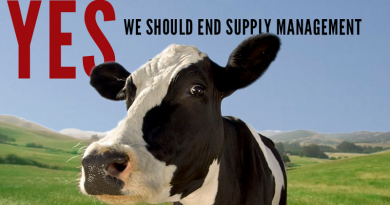No More Questioning Again Of The Milk Retail Pricing Policy By The Régie
“The Régie informs you that the issue of maintaining or not the Regulation is no longer considered at this stage”.
In this one little sentence, included in an innocuous e-mail sent last week by the Secretary of the Régie des marchés agricoles et alimentaires du Québec (RMAAQ) to Quebec representatives of the milk distribution channel, Jaafar Bouanane had just officially buried the organization’s long existential quest that took several years on its role and responsibility for milk pricing.
It is indeed extremely rare to see a Quebec regulator interested at letting go one of its powers. Yet this is what the RMAAQ has undertaken several years ago with regard to the pricing of retail milk, by publicly questioning its relevance, legitimacy and even its ability to establish year after year a fair retail price of milk in an extremely complex environment, and to kick-off an open consultation on the topic.
History of an unusual journey
How a regulatory body comes to question its own power and how it subsequently closes the door to this exercise is singular enough to see and understand.
First, the RMAAQ decided in September 2013 to hold a public meeting to decide “whether it is justified and still possible” to continue to regulate the prices of fluid milk and, if so, to determine what milk categories, types of markets and pricing arrangements should be regulated. Quite a program indeed!
A consultation was therefore held on January 29, 2014 with the stakeholders, based on a discussion paper drafted by the organization and the MAPAQ (the agriculture Quebec Ministry). The latter specified the parameters of the reflection in progress:
- What should be the objectives of regulating milk prices?
- How is the regulation of milk prices the only or best way to achieve these objectives?
- If so, what should be the categories of milk covered by the regulation (regular, value added,% fat, formats, other)?
- If so, at what level of marketing should the regulation apply (home delivery, over-the-counter sales, retail sales, other)?
- If so, what method should the Régie use to set prices? Justify the proposed methodology for:
– Frequency of comprehensive reviews;
– Frequency and modalities of readjustments.
- Financing of the method of fixing prices and consequences, if any, of refusal or inability to assume costs.
- What would be the consequences of deregulating milk prices in Quebec?
If the RMAAQ thought it was rendering a service to the industry, it was totally misguided because at the public consultation meeting, no group wanted to walk the organization’s path (see Decision 10699, which details the position of each industry association):
- The Quebec Milk Producers was in favor of regulation, “to maintain a stable environment in the dairy industry”;
- Agropur too, even highlighting the specter “of a decrease in the supply of products and the increase of the prices of the milk in certain markets or regions, or even the abandonment of the service due to lack of profitability”, all in the event of a deregulation ;
- The Quebec Dairy Industry Council (CILQ) declared itself for the status quo;
- The Retail Council of Canada (RCC), went further and lectured the Régie: it is not its role to question itself, it is the legislator’s! Its role is to apply legislation, period!
- The Association des détaillants en alimentation (ADAQ) also wanted minimum prices to be maintained, with the aim of preventing milk from becoming a “loss leader” (an item sold at a loss to attract customers);
- As for the Quebec Cooperative Association for Family Economics (ACEF), it has roughly declared itself in favor of reinforcing current regulations, i.e. by eliminating exceptions to the regulated prices such as filtered milk, as well as lowering the maximum price.
Without taking any stance on the core issue (apart from recognizing the industry’s “consensus” in favor of maintaining milk pricing) nor the slightest transcendental analysis of its future role, the Régie simply concluded by requesting industry representatives to provide additional studies on the costs of milk sale and distribution to update its price indexation mechanism.
Moreover, it surprised everyone with a unexpected decision: henceforth, certain milk product currently considered as “value added” will now be excluded from this category: “Milk having undergone a microfiltration or a multi centrifugation and those that are sold in plastic containers or in cardboard containers will no longer be part of the added-value category”. Ouch!

Exempt milk allows industry to grow
This unexpected decision has the disastrous effect of capping the price of a wide range of fluid milk products, whereas now, they are currently excluded from such caps and can be sold at any price.
For example:
- a 2 L of 2% milk in a plastic container currently sold for about $ 4.55 would now be sold at a maximum price of $ 3.60 (a 21% decrease);
- a 2 L microfiltered 2% milk currently sold about $4.79 would now be sold at a maximum price of $ 3.60 (a decrease of 25%).
Of course, the industry did not like it at all, and a motion to suspend the Régie’s decision was tabled quickly, effectively putting a freeze on its application.
On November 24, 2015, a public meeting was held to hear the industry motives behind the suspension request. During this session, Agropur and the CILQ committed to submit new studies justifying the statu quo, which was tabled in April 2016. Another public meeting was held shortly thereafter.
Then, on June 6, 2016, the Régie backtracked completely: The microfiltered milks, in plastic containers and with added vitamin D will not be subject to a maximum price.
All that remains to be determined in the end is for the Régie to better understand the distribution costs to fix the price of milk more precisely.
In short, we are back to square one. What about, then, the initial existential questioning of the Régie’s role in milk pricing, asked one of the associations recently ?
Answer: “The Régie informs you that the issue of maintaining or not the Regulation is no longer considered at this stage”.
And there you go. Any more question?






